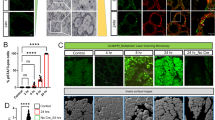Abstract
We previously demonstrated that expression of human FGF4 in the epithelial compartment of murine mammary glands caused hyperplasia during lactation and a dramatic delay in gland involution due to inhibition of cellular apoptosis. We now analyse the effects of transgene expression during development of the organ. Expression of WAP-Fgf4 initiate with the onset of sexual hormones (4 weeks of age), and defects in morphogenesis of the organ were already apparent at 5 weeks of age and persisted throughout all stages of post-natal development. These defects involved ductal development, but not lobuloalveolar morphogenesis, and were due to a decrease in the level of apoptosis within the terminal end buds. We also show that regulation of apoptosis by FGF4 in the mammary gland, both during development and involution, could occur via inhibition of Bcl2 expression. Overall our data demonstrate that FGF4 is a regulator of mammary epithelial cells apoptosis during all stages in which programmed cell death is an important mechanism of development, namely morphogenesis and involution. We also suggest that this growth factor could act by interfering with the Bcl2 pathway.







Similar content being viewed by others
Abbreviations
- FGF :
-
Fibroblast growth factors
- FGFr :
-
Fibroblast growth factors and their receptors
- MMPs :
-
Remodelling by metalloproteases
- PB :
-
Phosphate-buffered saline
- RT :
-
Room temperature
- TEB :
-
Terminal end buds
References
Chomczynski P, Sacchi N (1987) Single-step method of RNA isolation by acid guanidinium thiocyanate-phenol-chloroform extraction. Anal Biochem, 162:156–159
Coleman-Krnacik S, Rosen JM (1994) Differential, temporal and spatial gene expression of fibroblast growth factor family members during mouse mammary gland development. Mol Endocrinol 8:218–229
Cunha GR, Hom YK (1996) Role of mesenchymal-epithelial interactions in mammary gland development. J Mamm Gland Biol Neoplasia 1:21–35
Daniel C, Silberstein G (1987) Postnatal development of the rodent mammary gland. The Mammary Gland: Regulation, and Function. Neville MC, Daniel CW (eds) Plenum Press, New York, pp. 3–36
Daphna-Iken D, Shankar DB, Lawshé A, Ornitz DM, Shackleford GM, MacArthur CA (1998) MMTV-Fgf8 transgenic mice develop mammary and salivary gland neoplasia and ovarian stromal hyperplasia. Oncogene 17:2711–2717
Dunbar ME, Wysolmerski JJ (2001) Mammary ductal and alveolar development: Lesson learned from genetically manipulated mice. Microsc Res Tech 52:163–170
Henninghausen L, Robinson G (1998) Think globally, act locally: The making of a mouse mammary gland. Genes Dev 12:449–455
Humphreys RC, Krajewska M, Krnacik S, Jaeger R, Weiher H, Krajewski S, ReedJC and Rosen JM (1996) Apoptosis in the terminal endbud of the murine mammary gland: a mechanism of ductal morphogenesis. Development 122:4013–4022
Mailleux AA, Spencer-Dene B, Dillon C, Ndiaye D, Savona-Baron C, Itoh N, Kato S, Dickson C, Thiery JP, Bellusci S (2002) Role of FGF10/FGFR2b signaling during mammary development in the mouse embryo. Development 129:53–60
Jackson D, Bresnick J, Rosewell I, Crafton T, Poulsom R, Stamp G, Dickson C(1997) Fibroblast growth factor receptor signalling has a role in lobuloalveolar development of the mammary gland. J Cell Sci 110:1261–1268
Morini M, Astigiano S, Mora MR, Ricotta C, Ferrari N, Mantero S, Levi G, Rossini M, Barbieri O (2000) Hyperplasia and impaired involution in the mammary gland of transgenic mice expressing human FGF4. Oncogene 19:6007–6014
Muller WJ, Lee FS, Dickson C, Peters G, Pattengale P, Leder P (1990) The Int-2 gene product act as an epithelial growth factor in transgenic mice. EMBO J 9:907–913
Pardo OE, Arcaro A, Salerno G, Raguz S, Downward J, Seckl MJ (2002) Fibroblast growth factor-2 induces translational regulation of Bcl-XL and Bcl-2 via a MEK-dependent pathway: correlation with resistance to etoposide-induced apoptosis. J Biol Chem 277:12040–6
Quarrie LH, Addey CV, Wilde CJ (1995) Apoptosis in lactating and involuting mouse mammary tissue demonstrated by nick-end DNA labelling. Cell Tissue Res 281:631–642
Robinson GW, McKnight RA, Smith GH, Hennighausen L (1995) Mammary epithelial cells undergo secretory differentiation in cycling virgins but require pregnancy for the establishment of terminal differentiation. Development 121:2079–2090
Robinson GW, Karpf AB, Kratochwil K (1999) Regulation of mammary gland development by tissue interaction. J Mamm Gland Biol Neoplasia 4:9-19
Shillinford JM, Henninghausen L (2001) Experimental mouse genetics: Answering questions about mammary gland biology. Trends Endocrinol Metab 12:402–408
Silberstein GB (2001) Postnatal mammary gland morphogenesis. Microsc Res Tech 52:155–162
Spencer-Dene B, Dillon C, Fantl V, Kerr K, Petiot A, Dickson C (2001) Fibroblast growth factor signalling in mouse mammary gland development. Endocr Relat Cancer 8:211–217
Sympson CJ, Talhouk RS, Alexander CM, Chin JR, Clift SM, Bissell MJ, Werb Z (1994) Targeted expression of stromelysin-1 in mammary gland provides evidence for a role of proteinases in branching morphogenesis and the requirement for an intact basement membrane for tissue-specific gene expression. J Cell Biol 125:681–693
Tamatani M, Ogawa S, Nunez G, Tohyama M (1998) Growth factors prevent changes in Bcl-2 and Bax expression and neuronal apoptosis induced by nitric oxide. Cell Death Differ 5:911–9
Wagle A, Singh JP (2000) Fibroblast Growth Factor protects Nitric Oxide-induced apoptosis in neuronal SHSY-5Y cells. J Pharmacol Exp Ther 295:889–895
Wilkie AOM, Morriskay GM, Jones EY, Heath JK (1995) Functions of fibroblast growth factors and their receptors. Curr Biol 5:500–507.
Acknowledgments
We are grateful to Dr. Nicoletta Ferrari for her help with the PCR, and to Luca Boni for his technical assistance. This work has been supported in part by COFIN MURST to O.B.
Author information
Authors and Affiliations
Corresponding author
Rights and permissions
About this article
Cite this article
Astigiano, S., Damonte, P. & Barbieri, O. Inhibition of ductal morphogenesis in the mammary gland of WAP-fgf4 transgenic mice. Anat Embryol 206, 471–478 (2003). https://doi.org/10.1007/s00429-003-0317-6
Accepted:
Published:
Issue Date:
DOI: https://doi.org/10.1007/s00429-003-0317-6




